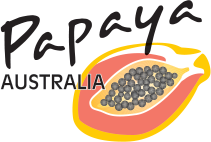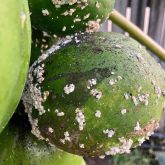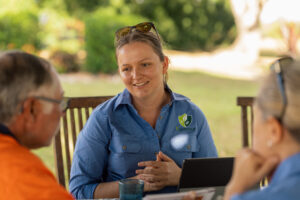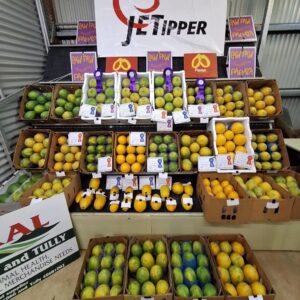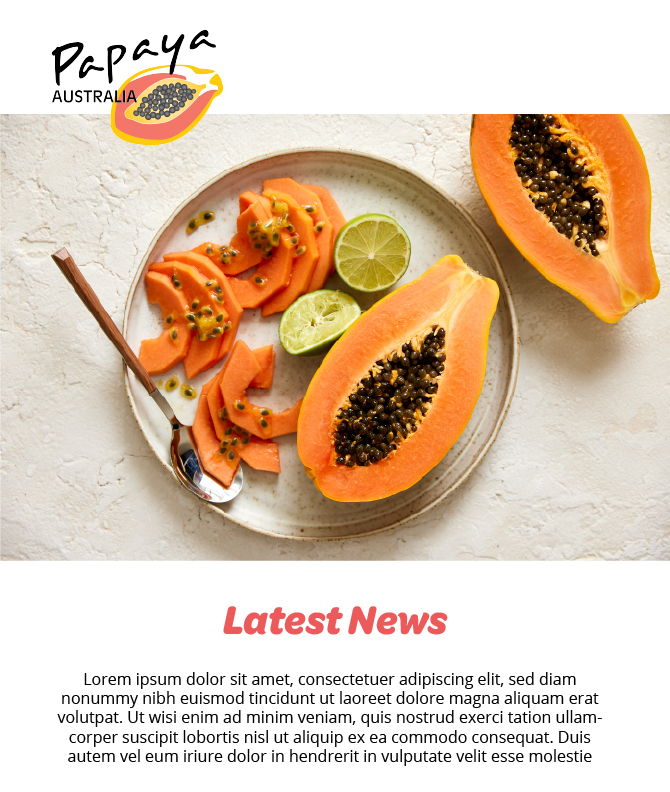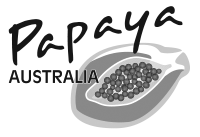For growers
Industry Resources and Levy Information
Project Directory
The project directory is designed to simplify an understanding of the outcomes of grower levy investment, both marketing and R&D. Below is a list of levy funded projects both in-progress and finalised. The links will take you to the Hort Innovation website where more information on the projects can be found.
CURRENT PROJECTS
R&D levy
This project aims to understand and manage Phytophthora, a destructive disease affecting papaya crops by improving detection, management practices, and overall production.
Hort Innovation | Better understanding of papaya phytophthora rot (PP23001)
This project is enhancing the productivity, profitability, and sustainability of the Australian papaya industry by providing growers with improved knowledge, practices, and proactive attitudes.
Hort Innovation | Supporting innovation in the Australian papaya industry (PP23003)
New red and yellow papaya varieties are continuing to be bred and evaluated under this program, which follows on from the investment New genetic targets to improve quality in papaya (PP15000). The research team is focused on delivering new elite, genetically stable cultivars that meet the needs of growers and the preferences of consumers, and that are adapted to key growing areas in northern Queensland, including the Tableland and coastal regions. The ultimate goal is to expand the marketability and profitability of the Australian papaya industry.
Hort Innovation | National papaya breeding and evaluation program (PP18000) (horticulture.com.au)
Through this project, levy funds and Australian Government contributions are used to submit renewals and applications for minor use permits for the papaya industry as required. These submissions are prepared and submitted to the Australian Pesticides and Veterinary Medicines Authority (APVMA).
Hort Innovation | Papaya industry minor use program (PP16000) (horticulture.com.au)
marketing levy and other
This project is delivering a comprehensive consumer tracking program across the Australian horticulture sector. Through monthly online surveys of nationally representative grocery buyers, the research captures key insights into consumer awareness, usage, purchase intent, and response to marketing campaigns across fresh fruit, vegetable, and nut categories. The data provides a consistent view of how consumer behaviours change over time in response to marketing efforts, seasonal shifts, and broader trends.
Hort Innovation | Consumer usage and attitude tracking 25/26 (MT24201)
The regulatory support and response coordination project aims to provide Australian horticultural industries support to navigate complex domestic and international pesticide regulations. The project supports industry sustainability by safeguarding access to essential plant protection products, enabling stakeholders to develop effective response strategies and make informed investment decisions.
Hort Innovation | Regulatory support and response co-ordination (pesticides) (MT24008)
Hort Innovation engages independent consultants to evaluate the impact of our R&D investments, providing insights into the type and magnitude of impacts that are being generated across the company’s strategic levy programs.
Hort Innovation | Horticulture Impact Assessment Program 2023/24 to 2025/26 (MT24005)
This investment provides a category tracking service to allow various horticultural categories to better understand consumer usage and attitudes and the effectiveness of marketing campaigns.
Hort Innovation | Consumer usage and attitude tracking 2023/24 (MT23201) (horticulture.com.au)
This project delivers the 2023 Strategic Agrichemical Review Process (SARP) for each of the following industries: almond, avocado, banana, berry, lychee, macadamia, melon, olive, onion, papaya, passionfruit, pineapple and summerfruit. SARPs provide an updated view of current priorities and gaps regarding pest, disease and weed control.
The generation of pesticide residue, efficacy and crop safety data is required to support label registration and minor use permit applications and renewals made to the Australian Pesticides and Veterinary Medicines Authority (APVMA).
This multi-industry investment is tasked with providing regular consumer behaviour data and insight reporting to a range of industries, through the Harvest to Home platform (www.harvesttohome.net.au).
The platform has a dedicated dashboard for each commodity, making data and reporting easily accessible for industry participants.
The information is intended to assist growers and supply chain partners in decision-making for their businesses and, for the wider industry, the data and insights will be available to support strategic activities.
Hort Innovation | Consumer behavioural data program (MT21004) (horticulture.com.au)
COMPLETED PROJECTS
R&D levy
Completed 2024
This project supported Australian papaya growers in adopting improved practices on-farm and keeping up to date with the latest industry news, information, resources, and technologies. Engagement with growers and supply chain stakeholders over the duration of the project led to an improvement in their knowledge, awareness, skills and aspirations, contributing to an increase in overall industry profitability and sustainability.
Hort Innovation | Papaya industry extension and communications program (PP20000)
Completed 2025
From 2022 to 2025, Papaya Australia collected data on weekly production volumes of red papaya and yellow paw paw from the primary growing regions of North Queensland. The goal was to establish a consistent and reliable dataset to better understand production trends and support more informed decision-making.
Hort Innovation | Papaya market supply data capture and analysis (PP20003)
Completed 2021
In 2021, this short project reviewed existing scientific evidence for the nutrient requirements of papaya in commercial production (especially nitrogen and phosphorus), in support of sustainable Australian production and to identify knowledge gaps which may require further research.
Hort Innovation | Nutrient requirements for papaya production (PP20002) (horticulture.com.au)
Completed 2020
This program, which ran from 2017 to 2020, provided effective and timely communications to ensure Australian papaya growers and other industry stakeholders were kept up-to-date with the latest R&D outcomes, marketing activities, and other industry news and information.
Hort Innovation | Australian papaya industry communication program (PP16001) (horticulture.com.au)
Completed 2018
his investment was tasked with undertaking consumer research to better understand papaya consumption in Australia. It undertook quantitative surveys and analysis to identify Australia’s key papaya consumers and why, how and how often they eat the fruit, while also looking at barriers to purchase or increasing consumption, and identifying ways these barriers can be overcome.
Hort Innovation | Papaya consumer research (PP17001) (horticulture.com.au)
Completed 2022
This investment, which ran from 2018 to 2022, worked towards the development of new testing protocols and the delivery of clean material to help protect the papaya industry against papaya sticky disease.
Hort Innovation | Papaya clean seed program (PP18001) (horticulture.com.au)
Completed 2018
With a focus on improving the quality of Australian papaya and producing elite, uniform cultivars, this investment began in 2016 to assist breeding now and in the near future, and to support industry development.
Hort Innovation | New genetic targets to improve quality in papaya (PP15000) (horticulture.com.au)
Completed 2016
The overarching aim of this project, which ran between 2011 and 2016, was to allow for improved management of fruitspotting bugs, which are major native pests that affect a large range of fruit and nut crops in Australia. The goal was to investigate more strategic, long-term and sustainable management approaches than the current single-target approach using broad-spectrum insecticides.
Hort Innovation | A multi-target approach to fruitspotting bug (MT10049) (horticulture.com.au)
Completed 2016
This project investigated control and management options for growers to reduce postharvest decay of papaya caused by fungal diseases. This was critical research given the industry reports annual yield losses to postharvest decay of 20 to 40 per cent.
The project evaluated the effectiveness of pre-harvest applications of difenoconazole in spray programs with protectant fungicides; the impact of regularly removing senescent leaves and disease infected fruit; as well as postharvest hot water treatment.
Completed 2017
This project was focused on developing an understanding of the cultivar requirements for commercial papaya growers. The findings were to improve the industry’s plant breeding and selection program, benefiting productivity and profitability for growers.
Funding from the project, which ran from 2014 to 2017, allowed the employment of an industry development officer and a one-year project for a papaya researcher. The officer liaised with growers, researchers and stakeholders and organised regional field days to promote peer-to-peer interaction and the exchange of industry knowledge and issues.
Completed 2015
The Australian papaya industry needs new varieties of both yellow and red papayas, with high uniformity, disease resistance, good eating qualities and consistent yield.
This project, which ran from 2011 to 2015, set out to breed new commercial lines with favourable characteristics. This breeding program evaluated twenty-seven lines and breeding selections were made on the basis of 11 productivity traits and 13 characteristics related to fruit quality, based on both grower and consumer preferences.
Completed 2015
The use of ethephon as a de-greening or ripening agent is considered by the Australian papaya industry to be critical. Fruit harvested during the cooler winter months often fails to develop the consumer-desirable, ripe skin colours, even though the fruit is at harvest maturity and internally is ripe and ready to consume. Green fruit is less marketable and consequently down-graded or discarded.
This project, which ran from 2014 to 2015, investigated the effectiveness of the synthetic plant-growth regulator, ethephon, to enhance colour development of winter-harvested papayas.
marketing levy and other
Hort Innovation engaged independent consultants to evaluate the impact of our R&D investments, providing insights into the type and magnitude of impacts that are being generated across the company’s strategic levy programs.
This is a key piece of investment evaluation work, and a yearly process for the company, which began through the project Ex-post impact assessment (MT18011) and continued through this program.
Hort Innovation | Horticulture Impact Assessment Program 2020/21 to 2022/23 (MT21015)
This investment provided a category tracking service to allow various horticultural categories to better understand consumer usage and attitudes and the effectiveness of marketing campaigns.
Hort Innovation | Consumer usage and attitude tracking 2022/23 (MT21202) (horticulture.com.au)
Completed 2024
This project ensured that Hort Innovation and related industries were well-informed about regulatory activities that could affect access to plant protection products, both within Australia and internationally.
Hort Innovation | Regulatory support and coordination (pesticides) (MT20007)
Completed 2024
This project developed individual Biosecurity Plans for the Australian lychee, papaya and passionfruit industries. Each plan identifies and prioritises the growing number of exotic pests and pathogens that could, if introduced, impact crop production and trade for these industries. Plans also assess the preparedness resources needed to manage these risks and outline a program of current and future activities to strengthen biosecurity responses and industry preparedness
Hort Innovation | Biosecurity plan for the lychee, papaya and passionfruit industries (MT18006)
Completed 2022
This multi-industry investment provided regular consumer behaviour data and insight reporting to a range of industries, through the Harvest to Home platform (www.harvesttohome.net.au).
The platform has a dedicated dashboard for papayas, making data and reporting easily accessible for industry participants.
The information is intended to assist growers and supply chain partners in decision-making for their businesses and, for the wider industry, the data and insights will be available to support strategic activities, as well as Hort Innovation Papaya Fund marketing plans.
Ended 2021
Among other things, this project provided the Australian horticulture industry with key information regarding domestic and international pesticide regulation. A component of this was the production of Ag Chemical Updates, which are available to download from this page. These updates provided information on any developments in regulatory oversight of relevant chemicals, and are an opportunity for industry to consider and develop responses to issues arising from actions proposed that may impact on grower ability to access and use needed pesticides.
Hort Innovation | Regulatory support and coordination (pesticides) (MT17019) (horticulture.com.au)
Finished 2020
In 2020, Hort Innovation developed The Good Mood Food campaign to deliver an immediate and enduring behaviour-change message to motivate more Australians to eat more fruit, veg and nuts, both during and beyond the COVID-19 pandemic. It’s a direct-to-consumer marketing initiative playing out across the country using a range of channels, including TV, newspapers, radio, online, social media and retail partnerships.
Completed 2023
From 2016 to 2023, this investment identified key pollinators across different Australian crops and produced recommendations for pollination management to optimise yields and minimise the risk of pollination failure.
The project delivered best practice pollination information for six crops, presented in concise, crop-specific manuals.
Completed 2020
During 2020, Hort Innovation worked with research company Fiftyfive5 to provide the Australian horticulture sector access to regularly updated information about consumer attitudes and behaviours during the time of COVID-19 disruption, through Fiftyfive5’s Category and Consumer Impact Monitor.
Hort Innovation | Category and Consumer Impact Monitor (ST19031) (horticulture.com.au)
Completed 2002
This report presented findings of consumer research carried out for the papaw industry in 2002.
The aims of the project were to:
- Provide feedback on current consumer purchasing and consumption patterns for papaws.
- Identify consumer preferences for product quality attributes for papaws.
- Identify factors which would encourage consumers to purchase papaws more frequently than they do at present.
Hort Innovation | Consumer research for the papaw industry (FR02044) (horticulture.com.au)
